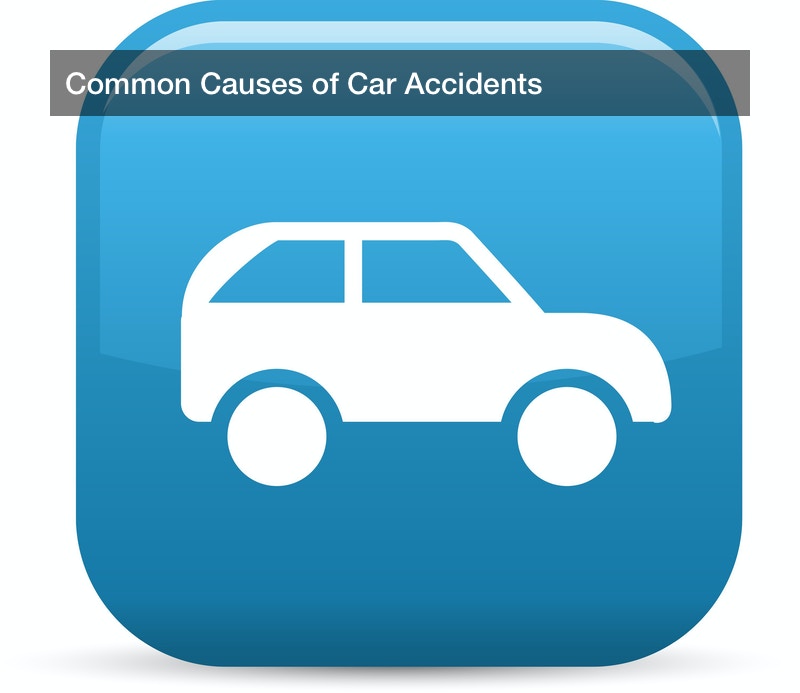
Car accidents are an unfortunate, and common, occurrence. On average, a driver will have a collision serious enough to file an insurance claim every 18 years. While this might not seem like a lot of crashes, keep in mind that this statistic only includes major crashes that require an insurance claim and excludes fender benders. The average person drives into their 70s, meaning you will probably have about three crashes during your driving career that result in property damage or an injury serious enough to notify your insurance company.
In 2008, the National Highway Traffic Safety Administration (NHTSA), an agency within the U.S. Department of Transportation, conducted an extensive study about the most common causes of car accidents. Similarly, in 2016, the Insurance Information Institute (III), an insurance industry research group, published a study on both the causes and costs of auto accidents.
Here are 10 of the finding from those studies about the common causes of car accidents as well as how drivers and insurance companies deal with them:
Traffic
This might seem intuitive, but the data shows that one of the most common causes of car accidents is other cars. That is, about 30% of auto accidents are single car accidents, while 70% of car accidents involve two or more cars. In fact, the majority of car accidents — about 57% of them — are two-car accidents.
Among multi-car accidents, most occur when one car turns into the path of the other car or one car rear-ends the other. Head-on collisions, T-bone collisions, and collisions during U-turns, reversing, or other maneuvers make up fewer than 20% of all car accidents.
This is one the primary reason that drivers’ education teaches emphasize defensive driving. While on the road, you must be aware of other drivers and anticipate the dangers they can pose.
For example, the most common accident configuration occurs when one driver turns into the path of another driver. This typically involves one driver turning left across traffic at an intersection or driveway.
Driving defensively would have both drivers poised to avoid the accident rather than merely trying to get where they want to go. The turning driver would wait, anticipating that the oncoming traffic might not slow to allow the turn or might even speed up. The oncoming driver might slow down and cover the brake, anticipating that the turning driver might try to beat traffic and make the turn. By driving defensively, both drivers avoid the accident and the car dent repair that goes with it.
Age and Gender
Age is one of the most significant predictors of whether a driver will be in a car accident, with inexperience being one of the most common causes of car accidents. Boys between the ages of 16 and 25 are involved in more accidents than any other age and gender group, while girls between the ages of 16 and 25 are a close second.
Gender also predicts who is more likely to get into a car accident, although the difference is less pronounced. Male drivers are about 9% more likely to be involved in a car accident than female drivers.
Moreover, male drivers are more likely to be killed in a car accident than female drivers. In a strange twist, however, female drivers are more likely to suffer an injury, with male drivers over 50% more likely than female drivers to walk away from an accident uninjured.
Of interest to insurance companies and personal injury lawyers, is why male drivers are more likely to get into a car accident than female drivers. The average male driver drives more miles per year than the average female driver. This provides more opportunities to get into accidents. Furthermore, male drivers are more likely to engage in the risky behaviors that are common causes of car accidents, such as aggressive driving, driving without a seat belt, and driving while impaired by drugs or alcohol.
Driver Error
Among causes attributable to drivers, mistakes are the most common causes of car accidents. The NHTSA study categorized driver mistakes into four categories.
- Recognition error: Recognition error was the most common form of driver error. Recognition error occurs when the driver failed to see the condition that caused the accident. Distractions, inattention, and improper lookout are common causes of car accidents arising from recognition errors.
- Decision error: Decision error was the second most common form of driver mistake. Decision errors occur when the driver sees the dangerous condition, but acts anyway. For example, speeding, tailgating, and misjudging the speed or direction of another car are common causes of car accidents arising from decision errors.
- Performance error: Performance error occurred in only about 10% of car accidents caused by driver mistakes. Performance errors include overcorrection and panic.
- Non-performance error: Non-performance errors are relatively uncommon causes of car accidents at just 7%. The two most frequent non-performance errors are falling asleep at the wheel and having a medical issue that causes the driver to lose control of the vehicle.
Some of these errors can merely result in the vehicle exiting the roadway and can be cured by simply calling for tow truck assistance. However, according to the NHTSA’s data, driver errors lead to about 2 million car accidents in the U.S. every year that result in hundreds of thousands of major injuries.
Distracted Driving
Although the NHTSA study includes distracted driving with other forms of driver error, it bears a separate discussion because it has grown quickly. It has grown so quickly that 20 states plus DC ban use of handheld cell phones and 48 states plus DC ban texting while driving.
However, distracted driving is not limited to cell phone use. Drivers are commonly seen engaging in all kinds of activities that distract from their ability to drive effectively including:
- Eating
- Reading
- Putting on makeup, brushing teeth, styling hair
- Internet browsing
All of these activities draw your attention from driving. Keep in mind that even at a relatively slow 30 miles per hour, your car travels 44 feet in one second. Although you might be in the market for a car, causing a collision because you looked at your phone for just one second is not the way to find your way to used car dealers.
Impaired Driving
Another driver-related factor that is, unfortunately, one of the most common causes of car accidents, is impaired driving. Impaired driving accounts for over 10,000 deaths on American roads every year. In 2018, these deaths due to drunk or drugged driving accounted for about 30% of all traffic deaths.
Impaired driving, like distracted driving, is largely preventable. Every state have criminal laws against driving while intoxicated with drugs or alcohol. Violating these laws could result in a driver being sentenced to jail and a hefty fine.
In addition to the risks of death, injury, jail, and fines, impaired driving has other potential costs including:
-
- Bail: The driver could have to work with bail agents to post bail so the driver can be released while awaiting trial. If the driver does not post bail, the driver could wait in jail months while waiting for a court date.
- Impound: The driver’s car will be towed and impounded. The driver will have to pay impound fees, storage fees, and towing expenses to recover the car.
- License suspension: Most states provide for automatic driver’s license suspension. Those that do not, usually give judges the authority to order suspension if the driver is convicted of impaired driving.
- Insurance: The driver’s insurance rates will go up or the driver will be uninsurable. As a result, the driver will have difficulty getting a job where driving is part of the job duties.
Equipment Failure
It might seem like an excuse, but about 44,000 crashes every year are caused by mechanical failure of the vehicle. Many drivers fail to maintain their vehicles and even among those who do, they can be caught unaware when they drive a borrowed vehicle or a car or truck rental.
The NHTSA study breaks down equipment failures down into specific systems in the vehicle.
-
-
- Tire and wheel failure was at the top of the most common causes of car accidents due to mechanical failure at over 40%.
- Brake failure was the second most common mechanical failure.
- Steering failure and “other failure” were the final two groupings of mechanical failures.
-
Fortunately, these kinds of accidents are avoidable. Mechanical failures can be prevented with regular maintenance from a qualified technician that knows your vehicle, such as Ram service for Dodge vehicles.
Road and Weather Conditions
Most traffic accidents occur during daylight in clear, sunny conditions. This makes sense because traffic is heaviest during daylight hours. However, road conditions and weather conditions still contribute to about 50,000 vehicle accidents per year. The most common contributing factor is slick roads caused by rain, snow, ice, and loose debris. Slick roads contribute to about half of all accidents that result from road and weather conditions.
Among weather conditions, glare causes about four times as many accidents as fog, rain, and snow combined. This might seem counter-intuitive. However, since most accidents occur during daylight hours, glare is one of the most common weather conditions experienced in these accidents.
In addition to directly contributing to vehicle accidents, weather and road conditions can exacerbate other causes. For example, dust can contaminate a vehicle’s lubricant without filters and chemical treatment to remove ultra fine solids. Similarly, precipitation can reduce visibility, leading to improper lookout errors, and slick roads can reduce the margin for error for distracted or impaired drivers.
Fuel Costs
One surprising contributing factor to car accidents is the cost of gasoline and diesel fuel. When fuel is cheap, people drive more. When gasoline is inexpensive, consumers spend more on entertainment and travel because they feel wealthier and the growth in cost of most goods and services slows down.
Moreover, low fuel costs provide a boost to the economy. With shipping and manufacturing costs contained, goods are cheaper. This results in more goods moving through the economy.
The impacts of cheap fuel on consumers and businesses puts more cars and trucks on the roads. As noted above, heavy traffic is one of the most common causes of car accidents. Thus, fuel costs indirectly contribute to an increase in the number of car accidents.
Cost of Accidents
Every state in the U.S. requires drivers to maintain auto insurance. For example, the Florida Financial Responsibility Law requires drivers to maintain liability insurance to cover bodily injury and property damage that results from any crash caused by the driver.
A study by the III found that the size of insurance claims has increased faster than the rate of inflation. Specifically, claim sizes have increased by about 6% per year even though inflation has increased prices by only about 4% per year.
Interestingly, the primary cause of this increase has not been the cost of new auto sales. Instead, the III study found that increases in the cost of labor to repair vehicles and medical treatment account for almost all of the increase. In fact, the cost of medical treatment has been one of the fastest growing costs in the American economy. This has indirectly increased costs of many goods and services that Americans’ use, including the cost of auto insurance claims and premiums.
Impact on Auto Insurers
Since everyone is required to buy auto insurance, you might think that this is a highly profitable business. However, insurance companies that service auto insurance policies have been squeezed in a few ways.
-
-
- Number of auto accidents is increasing: The number of auto accidents has increased. The III attributes the increase to many factors including population growth, heavier traffic, an increase in the freeway speed limits, and an increase in the number of miles that people drive.
- Cost of auto accidents is increasing: As mentioned above, an increase in the cost of medical treatment has increased the cost of auto accident claims.
- Low interest rates: Insurance companies are heavily involved in financial services and investments. Insurance companies are required by state laws to maintain a reserve to cover claims. These reserves are usually invested in interest-bearing accounts. While this ensures the reserves are save, these accounts have produced low rates of returns due to low interest rates.
- Turbulent financial markets: To balance out historically low insurance rates, insurance companies invest premiums in other financial products. Volatility and outright collapse of these financial products in 2008 led to difficult financial times for many insurance companies.
-
Everyone can benefit from understanding the common causes of car accidents. Many of the causes of car accidents are preventable. For example, impaired driving can be addressed with phone apps that lock or silence the phone while it is in motion. Similarly, impaired driving can be addressed with acknowledging when a driver is too impaired to drive safely and calling for a taxi or ride share.
Other causes can be mitigated. For example, maintenance can reduce the risks and effects of vehicle failure as a contributing factor to car accidents. Similarly, learning and applying defensive driving techniques can reduce driver error and carelessness as a cause of vehicle accidents. Finally, helping municipalities identify road hazards and pressing them to repair them can reduce impact of road and weather hazards on drivers.
By understanding the causes and addressing them, you can help reduce the 38,000 deaths and 4.4 injuries every year from car accidents.








